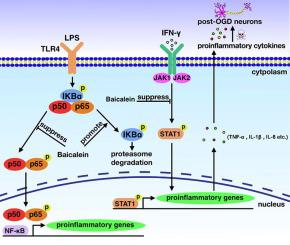Brain Research ( IF 2.7 ) Pub Date : 2021-08-19 , DOI: 10.1016/j.brainres.2021.147626 Yuanyuan Ran 1 , Shuyan Qie 1 , Fuhai Gao 1 , Zitong Ding 1 , Shuiqing Yang 1 , Guiqin Tian 1 , Zongjian Liu 1 , Jianing Xi 1

|
Microglial polarization mediated neuroinflammation plays an important role in the pathological process of stroke. The aim of this study is to determine whether baicalein indirectly ameliorates neuronal injury through modulating microglial polarization after stroke and if so, then by what mechanism. The effects of baicalein on microglial polarization were revealed through the middle cerebral artery occlusion mouse model (MCAO, n = 6), the lipopolysaccharide (LPS) + interferon-γ (IFN-γ) and oxygen-glucose deprivation (OGD) induced neuroinflammatory microglia model (BV2, n = 3), respectively. Mice were treated with baicalein (100 mg/kg, i.g.) after reperfusion, and followed by daily administrations for 3 days. Results showed that the infarct volumes at 3 d in vehicle and baicalein-treated MCAO mice were 91.18 ± 4.02% and 55.36 ± 4.10%. Baicalein improved sensorimotor functions (p < 0.01) after MCAO. Real-time PCR revealed that baicalein decreased proinflammatory markers expression (p < 0.05), while elevated the anti-inflammatory markers (p < 0.05) in vivo and in vitro. Both western blot and immunofluorescent staining further confirmed that baicalein reduced proinflammatory marker CD16 levels (p < 0.01) and enhanced anti-inflammatory marker CD206 or Arg-1 levels (p < 0.05). Notably, baicalein suppressed the release of proinflammatory cytokines (p < 0.05) and nitric oxide (NO, p < 0.001). Mechanistically, baicalein prevented increases in TLR4 protein levels (p < 0.001), the phosphorylation of IKBα and p65 (p < 0.01), and the nuclear translocation of NF-κB p65 (p < 0.05). The NF-κB inhibitor, BAY 11-7085, enhanced the inhibitory effect of baicalein on the proinflammatory microglial polarization. Baicalein also inhibited the phosphorylation of signal transducer and activator of transcription 1 (STAT1, p < 0.001). A microglia-neuron co-culture system revealed that baicalein driven neuroprotection against OGD induced neuronal damage through modulating microglial polarization (p < 0.05). Baicalein indirectly ameliorates neuronal injury after stroke by polarizing microglia toward the anti-inflammatory phenotype via inhibition of the TLR4/NF-κB pathway and down-regulation of phosphorylated STAT1, suggesting that baicalein might serve a potential therapy for stroke.
中文翻译:

黄芩素通过抑制 TLR4/NF-κB 和 STAT1 通路抑制促炎性小胶质细胞极化改善缺血性脑损伤
小胶质细胞极化介导的神经炎症在中风的病理过程中起重要作用。本研究的目的是确定黄芩素是否通过调节中风后小胶质细胞极化间接改善神经元损伤,如果是,那么通过什么机制。通过大脑中动脉闭塞小鼠模型(MCAO,n = 6)、脂多糖(LPS)+干扰素-γ(IFN-γ)和氧-葡萄糖剥夺(OGD)诱导的神经炎性小胶质细胞,揭示了黄芩素对小胶质细胞极化的影响。模型(BV2,n = 3),分别。用黄芩素 (100 mg/kg, ig) 再灌注后,然后每天给药 3 天。结果显示,载体和黄芩素处理的 MCAO 小鼠 3 d 的梗死体积分别为 91.18 ± 4.02% 和 55.36 ± 4.10%。黄芩素改善了 MCAO 后的感觉运动功能 ( p < 0.01)。实时荧光定量 PCR 显示,黄芩素在体内和体外均降低了促炎标志物的表达( p < 0.05),而提高了抗炎标志物的表达( p < 0.05 )。蛋白质印迹和免疫荧光染色均进一步证实黄芩素降低促炎标志物 CD16 水平 ( p < 0.01) 并增强抗炎标志物 CD206 或 Arg-1 水平 ( p < 0.05)。值得注意的是,黄芩素抑制促炎细胞因子 ( p < 0.05) 和一氧化氮 (NO, p < 0.001) 的释放。从机制上讲,黄芩素阻止了 TLR4 蛋白水平的增加 ( p < 0.001)、IKBα 和 p65 的磷酸化 ( p < 0.01) 以及 NF-κB p65 的核转位 ( p < 0.05)。NF-κB 抑制剂 BAY 11-7085 增强了黄芩素对促炎性小胶质细胞极化的抑制作用。黄芩素还抑制信号转导和转录激活因子 1 (STAT1, p < 0.001)。小胶质细胞-神经元共培养系统显示,黄芩素通过调节小胶质细胞极化来驱动针对 OGD 诱导的神经元损伤的神经保护作用 ( p < 0.05)。黄芩素通过抑制 TLR4/NF-κB 通路和下调磷酸化 STAT1 使小胶质细胞向抗炎表型极化,从而间接改善中风后的神经元损伤,这表明黄芩素可能是中风的潜在治疗方法。









































 京公网安备 11010802027423号
京公网安备 11010802027423号